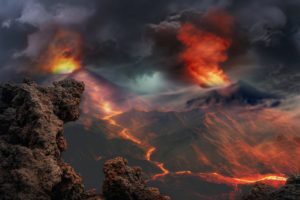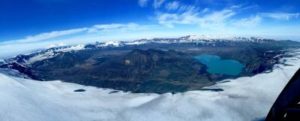
PROCEEDINGS OF THE NATIONAL ACADEMY OF SCIENCES—According to a study*, a massive volcanic eruption in Alaska in 43 BCE coincided with the fall of the Roman Republic and subsequent rise of the Roman empire. The years following the assassination of Julius Caesar in 44 BCE were among the coldest of the last 2,500 years, with inclement weather and widespread famine. Joseph R. McConnell and colleagues report that a massive volcanic eruption in 43 BCE may have been responsible for the unusual atmospheric and climatic events that coincided with the fall of the Roman Republic and the Ptolemaic Kingdom, which subsequently led to the rise of the Roman Empire. The authors obtained high-resolution measurements of volcanic fallout, including tephra, in six dated Arctic ice cores. The authors found evidence of two high-latitude volcanic eruptions. The effects of the first eruption, in 45 BCE, appeared short-lived and limited in scale. In early 43 BCE, however, the second eruption produced fallout that lasted 2 years and coincided with temperature anomalies in tree-ring and cave records. Geochemical analysis of the tephra identified particles unique to the Okmok volcano in Alaska. Earth system modeling of the eruption’s effect on the ancient Mediterranean climate showed pronounced cooling, especially in summer and autumn, and markedly increased precipitation. Such climate conditions likely resulted in crop failures, famine, and disease, exacerbating social unrest and contributing to political realignments throughout the Mediterranean region, according to the authors.
_____________________________

The 10-km wide caldera on Alaska’s Unmak Island formed during the 43 BCE Okmok II eruption. This massive eruption caused among the most extreme Northern Hemisphere weather conditions of the past 2,500 years that coincided with the fall of the Roman Republic. Kerry Key (Columbia University, New York, NY)
_____________________________

Apparatus for continuous analysis of ice cores used to develop detailed records of volcanic fallout from the Okmok II eruption in 43 BCE. Joseph R. McConnell.
_____________________________
Article Source: PNAS news release
*”Extreme climate after massive eruption of Alaska’s Okmok volcano in 43 BCE and effects on the late Roman Republic and Ptolemaic Kingdom,” by Joseph R. McConnell et al.
Cover Image, Top Left: Enrique Lopez Garre, Pixabay
_____________________________
Advertisement




